Showing 1–9 of 1332 resultsSorted by latest
-
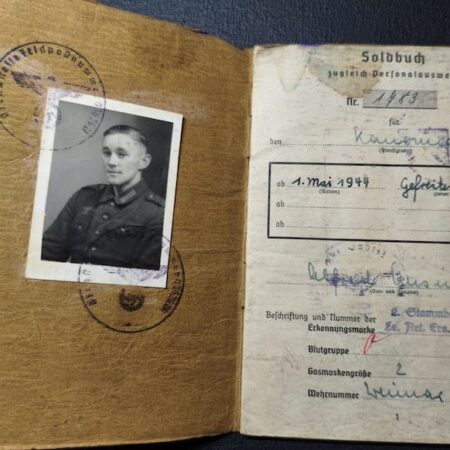
WWII Wehrmacht Soldbuch – Gefreiter Alfred Unsinn – Child Soldier 16 Years Old – Belfort Gap France 1944 – 159 Infanterie Division
$325.00Alfred Unsinn was born in August 1928 and was called up for duty at a very young age in 1943. In 1944 he was only 16 years old! Served with: Leichte Reserve Artillerie Abteilung 9 In December 1943 they were stationed in La Valbonne, France. Fought under: 159 Reserve Division / 159 Infanterie Division On January 8, 1944, the division was transferred to southern France and deployed to protect the Atlantic coast. After the Allied landings in southern France, the division retreated to Belfort, suffering heavy losses. Other details from the Soldbuch: Signature on Page 3 – 4. Batterie, Batterieführer, Oberleutnant Günther Nostitz It seems he was likely captured, the last entries are June 1944 and I was unable to find any references to him online. Given the fact the Swastica is removed it is a sign he may have been captured.
-
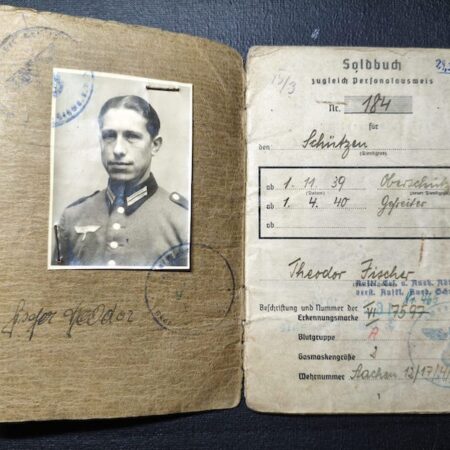
WWII Wehrmacht Soldbuch – Gefreiter Theodor Fischer – Grenzwach Regiment 46 – Siege of the Belgian Fortress Aubin-Neufchâteau 1940 !
$355.00Gefreiter Theodor Fischer from Richterich (Aachen) Germany, born in 1912 – in his civilian life he was a Miner! Soldbuch was issued in September 1939 with: Grenzwacht-Regiment 46 Unit was made up of Border troops from the Aachen area and took part in the Siege of the Belgian Fortress Aubin-Neufchâteau which was one of the forts in the Position Fortifiée de Liège (Festung Lüttich). During the 1940 Belgian campaign, Grenzwacht-Regiment 46 was known for its role in the brutal siege of the Fortress of Aubin-Neufchâteau, one of the forts in the Liège fortified position. After the fall of Fort Eben-Emael, Fort Aubin-Neufchâteau held out for eleven days against a massive German assault, including artillery, air attacks, and infantry assaults, before surrendering on May 21, 1940, due to exhaustion and lack of ammunition. The German forces, particularly the airborne troops, used a combination of glider landings, explosives, and flamethrowers to overcome the defenses, but the garrison’s valiant resistance impressed the attacking forces. Served also with: Radfahr-Bataillon 404 of the 263. Infanterie-Division in occupied Norway, and Radfahr-Abteilung 30 of the 30. Infanterie-Division. Until sometime in 1944 when he contracted some sort of stomach/intestine complains and was sent to various replacement units till the wars end. Soldbuch comes with his NSDAP Gesundheitspass which was in the rear of the Soldbuch.
-
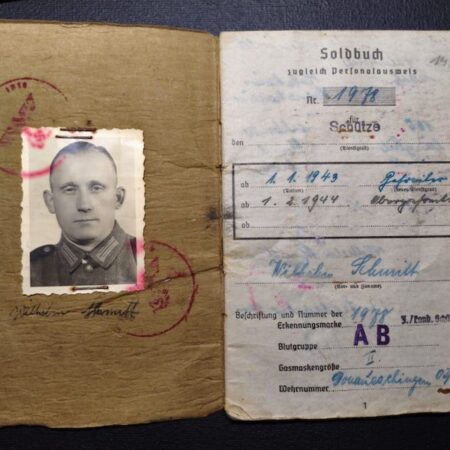
WWII Wehrmacht Soldbuch – Obergefreiter Wilhelm Schmitt – Sicherungs Batl 1018 – Issued Luger P08 Pistol – Wounded in Tarnow Poland 1945 – Wounds Badge – POW France 1947
$275.00Schmitt was born in 1903 and his Soldbuch was issued in September 1941. He served with: Sicherungs Batl 611 and Sicherungs Batl 1018The Sicherungstruppen ( security troops or covering troops in English, Sicherungstruppe in the singular) were German troops during the Second World War , responsible for maintaining order, ensuring the security and protection of lines of communication and guarding works behind the front line and in occupied territories. Security Battalion 1018 was formed on July 14, 1944, in the General Government. The battalion was created by renaming the II Battalion of Security Regiment 611 to four companies. After its formation, the battalion continued to be deployed in the General Government. In January 1945, the battalion suffered heavy losses near Tarnow, also in the General Government. Remnants of the battalion were later deployed in Upper Silesia. Schmitt was wounded by grenade fragments (31b) in January 1945 (likely near Tarnow Poland). He was later released in April 1945 and was sent to his unit again, although by that stage of the war who knows where he ended up, likely in an adhoc unit which sadly is not recorded in his Soldbuch. Although there are entries in French from a French POW Camp in 1947!
-
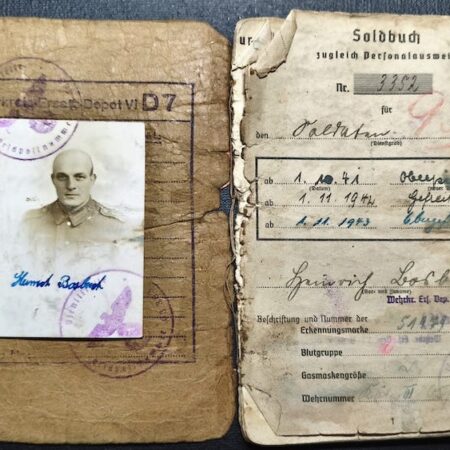
WWII Wehrmacht Soldbuch – Obergefreiter Heinrich Bosbach – Ost Batl 618 (Russisch) 15th Armee in Pas de Calais – Destroyed in Normandy 1944 – Rare!
$360.00Here we have a rather beat up but original Soldbuch to a really hard to find Westfront unit… Issued to Heinrich Bosbach who served with various Festung and Pioneer Units, until his deployment in 1944 with a rather rare unit! He was also awarded the War Merit Cross with the Ost Batl 618 in France in April 1944 (LXXXII Armee Korps). Ost Batl 618 (Russisch) – 15th Armee In the winter of 1943/44, most of the Ost battalions were detached from their divisions and corps and transferred to France after the Commander-in-Chief West had freed up corresponding German battalions for deployment on the Eastern Front. Some battalions went to Italy and Denmark. In the spring of 1944, most of these battalions were fully integrated into German regiments, partly as replacements for the detached battalions, partly as 4th Battalions. The Eastern Front battalions were mostly deployed in fortified positions along the English Channel, the Atlantic coast, or the Mediterranean coast. In the winter of 1944/45, the remnants of the battalions, most of which had been destroyed in France, were gathered at the Münsingen training area and used there to form Vlasov’s Russian Liberation Army (ROA). Ost Batl 618 was attached to the 15th Armee in Normandy where it was destroyed according to the Lexicon der Wehrmacht. I am not sure what happened to Bosbach, although the Soldbuch is not in the best condition, loose and missing the back cover.
-
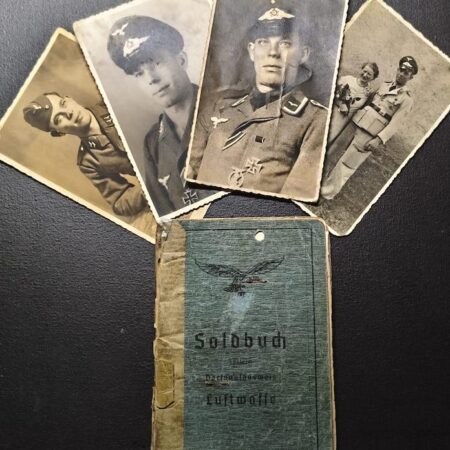
WWII Luftwaffe Soldbuch – Unteroffizier Herbert Richter – Schwere Flak Abteilung 231 – Iron Cross First Class / Flak Badge – 8.8cm Flak – Portrait Photos – Oder 1945
Richter was issued his Soldbuch in September of 1939 with the then Reserve Flak Abteilung 231. He would serve the most of the war with: Schwere Flak Abteilung 231 In 1939, the unit was stationed in Dresden, in 1940 in Belgium, and in 1941 in France. In the summer of 1942, the unit was deployed in the Bremen area. In July 1942, the unit was renamed Heavy Flak Battalion 231.. From 1943 to 1945, the unit functioned as Flak Group Vechta. By 1945 they were sent to the Oder Front. They are responsible in 1942 for claiming the downing of RAF Aircraft that crashed in Holland – info can be found on the web. He was awarded the Annexation Medal 1.10.1938, Iron Cross Second Class, Iron Cross First Class (not entered but he is wearing it in photos!), Flak Badge. A really neat little bit of paper at the front states that he was to get to his battery as soon aa any air raid was underway! His speciality was a Waffen Personal and he attended many courses as a Weapons Uffz!
-
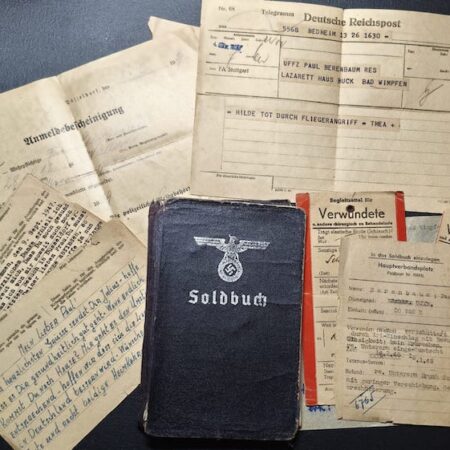
WWII Wehrmacht Soldbuch Grouping – Uffz Paul Berenbaum – Born in France! – Incredible Story Buried Alive by US Artillery – Grenadier Regiment 713 – 416 Inf Div West Wall 1945 – Mortar Team Leader – Rare!
$565.00Here we have a really tragic Soldbuch Grouping… Paul Berenbaum was born in Wallern (Vallieres Les Metz) France. He was enlisted into the German Army in February 1940. In 1940/1941 he served with: Infanterie Regiment 178 – 76 Infanterie Division – On the Western Front then in Poland. In 1942 he served with: Infanterie Regiment 441 – 416 Infanterie Division They served in Denmark, more can be found here including the places in which they were posted: https://www.lexikon-der-wehrmacht.de/Gliederungen/Infanteriedivisionen/416ID.htm In 1943/44 he served with Landeschützen Regiment 930 shortly before being assigned to Grenadier Regiment 713 in late 1942/early 1943. But by late 1944 he was assigned to the Feld Ersatz Batl 476 – 416. Infanterie-Division Issued a MP40 Machine Pistol On October 11, 1944, the division established a command post in Keuchingen near Mettlach/Saar. After the start of the Allied offensive across the Moselle on November 9, 1944, elements of the division were deployed in the ensuing defensive battles around Freching and Kerling. On November 17, 1944, the division’s command post was located in Tünsdorf, on November 18 in Orscholz, and on November 19 in Trassem. On November 28, the division headquarters was in Taben, and on December 3 in Taben-Rodt. On December 4, 1944, after a month of defensive fighting, the division still had a combat strength of 2,400 men, of whom 1,550 were infantry. Heavy fighting ensued around the West Wall, followed by a retreat to the Mettlach area and the Orscholz ridge. On January 14, 1945, the division still had a strength of 3,016 men. In the following weeks, the fierce defensive battles continued at the Orscholz ridge/Saar-Moselle triangle. Between February 7 and 28, 1945, the division suffered 2,195 casualties. According to his wounding tags, he was delivered on the 15.1.1945 in St Wendel with a suspected broken bone from being stuck/squeezed. According to a rather rare (never seen before) Soldbuch Paper which was to be put into the Soldbuch given by the main aid station (Hauptverbandplatz): “Verschüttet durch Artillerie einschlag mit Bewusstlosigkeit; kein erbrechen rechten unter arm eingequetscht” “Buried by artillery fire, unconscious; no vomiting, right arm crushed” After being examined the Doctor found his right arm was broken at the elbow, and he was suffering from concussion. He was transferred to Bad Wimpfen where he was to rest according to another piece of paper issued by the Hospital, although he would get a Telegram from his Wife that his relative Hilde was killed during an allied bombing raid on the 4th of March 1945. He would spend till the 28th of May 1945 in hospital recovering, before going into a POW Camp Nr 172 in Vernet d Àviege which was in fact a former Concentration Camp. https://en.wikipedia.org/wiki/Camp_Vernet Two Letters sent by his friend Julius Niggemann in 1947 read: My dear Paul! Warmest greetings from Julius. I hope you are in good health. When will you finally come home? Considering the circumstances, we hope that the situation in Germany will soon improve. I wish you all the best and a speedy return home – your Julius! My dear Paul! With heartfelt thanks I received your kind lines. I am glad to hear that you are still healthy and in good spirits — as far as I can say, I am as well. During my last visit to Düsseldorf, I unfortunately learned of the death of your dear wife. You must come to terms with this sad fact, however difficult the loss must be for you. I do hope now, with confidence, that you will soon be released. It truly is about time that our authorities finally come to that realization as well. Düsseldorf looks desolate, and yet, despite everything, new life is springing up from the ruins again. I am always amazed at how people manage to carry on with life. For today, I wish you all the best. Stay healthy and in good spirits until we can have a joyful reunion back home. Your ever-thoughtful friend. It seems his wife Thea Berenbaum died in December of 1945. Lastly a letter dated 18.6.1948 to the now released Paul Berenbaum living in the British Zone of Germany in Munster / Westfalhen shows that he made it out alive. Last comments His story is a tragic story, from being buried alive in combat and miraculously being pulled from the rubble unconscious, loosing family by bombing raids and later his wife whilst he was interned in a former Concentration Camp. A horrible time he experienced, one can only hope he lived peacefully after the war.
-
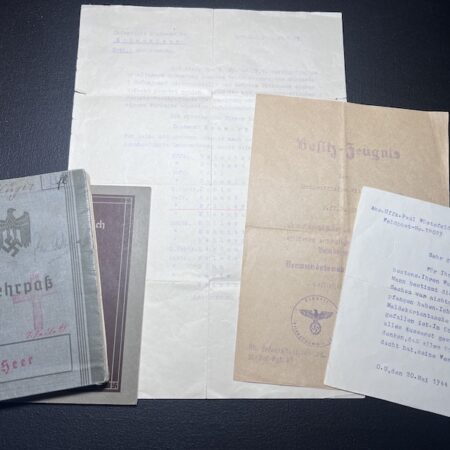
WWII German Wehrmacht Wehrpass KIA Grouping -Oberfeldwebel Pflüger – Saar Offensive 1939 Action Report – IR81 WIA France 1940 – Black Wounds Badge Certificate Le Hamal (Rare version!) Streifendienst – Grenadier Regiment Lublin
$375.00Interesting little grouping to Oberfeldwebel Pflüger Very interesting and unusual entry is that in September of 1939, he took part in the battle known as the Saar Offensive – when France invaded the Saarland in 1939!! “During a reconnaissance operation carried out by the 9th Company on 27 September 1939, despite difficult circumstances (captured prisoners, heavy rain, and several French soldiers put out of action), the mission was successfully completed. Through exceptional prudence and execution of the operation, it was possible to achieve success with minimal own losses.I express my recognition to the leader of the reconnaissance patrol” He was fighting in France with Infanterie Regiment 81, and was injured in a battle with French Soldiers in Le Hamal in June 1940. Medals: West Wall Medal, Iron Cross, Wounds Badge in Black He would serve in various other units including Streifendienst! Not often seen! He was later killed in action with Grenadier Regiment Lublin in Poland 1944. Final Comments The fact that he was involved in operations in September 1939 makes this grouping one of a kind, not many units actually took part in the fighting during the Saar Offensive, but having the typed letter naming him surely makes this quite a desirable item.
-

-
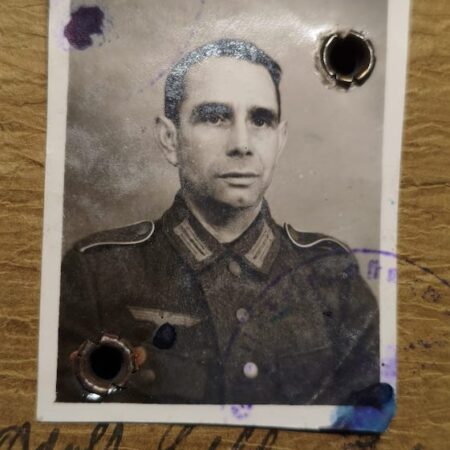
Original WWII German Wehrmacht – Soldbuch Gefr Adolf Edelkraut – Wounded in France July 1944 – 159 Reserve Division – Grenadier Regiment 74 – 19 VGD – Shot in Stomach – US 44th Infantry Division – Germany 1945
Soldbuch issued to Adolf Edelkraut born in Duisburg in 1907. Reserve Grenadier Batl 57 As part of the 159 Reserve Division they were stationed near Bordeaux France. On January 8, 1944, the division was deployed to southern France and deployed to protect the Atlantic coast. After the Allied landings in southern France, the division withdrew to Belfort, suffering heavy losses. Edelkraut was wounded with a Grenade Splinter (Soldbuch Code 31b) and delivered to hospital in Dax, France. Grenadier Regiment 74 – 19 Volks Grenadier Division In Early 1945, after healing he was deployed once again. January 3, 1945, the division was suffering heavy losses. The following weeks were characterized by hard fighting and hesitant resistance. On January 13, the division still had a combat strength of 1,500 to 2,000 men. After the costly retreat, the divisions of the XIII SS Army Corps were in the defense between Saarbrücken and Bitsch. No decisive fighting took place until the end of January 1945. Priority was given to the development of field positions and the reinforcement of the West Wall. On February 6, 1945, the US troops began a local attack against the right wing of the already severely weakened 19th Volksgrenadier Division. During these attacks, the US troops were able to capture the Blies Heights near the town of Saarguemines. The division was able to hold the remaining positions in front of the West Wall, but shrank to the strength of a weak divisional combat group. On March 15, the main attack by the American forces took place on a broad front against the West Wall. The defensive strength of the 19th Volksgrenadier Division declined rapidly, and the division was thrown back to the West Wall. On March 19, the division received orders to disengage from the front line with the remaining remnants and return to the Kaiserslautern area. In the following days, the remnants of the division were again dispersed. On March 24, it still had a strength of 400 men. On March 26, 1945, the division was officially disbanded. All that remained was the division headquarters. The remaining elements were combined into a combat group and assigned to the 2nd Mountain Division. At the beginning of April 1945, the remnants of the combat group were south of Dörzbach on the Jagst River. On April 21, the remnants of the combat group withdrew from the Crailsheim area toward Dinkelsbühl. From here, they continued toward Gingen an der Brenz. Here, their trail ends. More info: As the Allied counter-offensive against Operation Nordwind gained ground they were pushed by the US 44th Infantry Division. They fought alongside in February, then absorbed in March, the 340. Volksgrenadierdivision. The division was disbanded on 26 March 1945 in Waldangelloch, Bavaria, Germany and units were parcelled out to reinforce other units. It seems he was captured by US Forces, was badly wounded with a bullet wound in the stomach. He was quarantined due to the fact he had Typhus, and another bout of Malaria which he already had in 1943. As well as a back injury. He was released in the summer of 1946 and told to return home according to the Doctors Papers. His brother was killed in Normandy in 1944 – Wilhelm Edelkraut.




